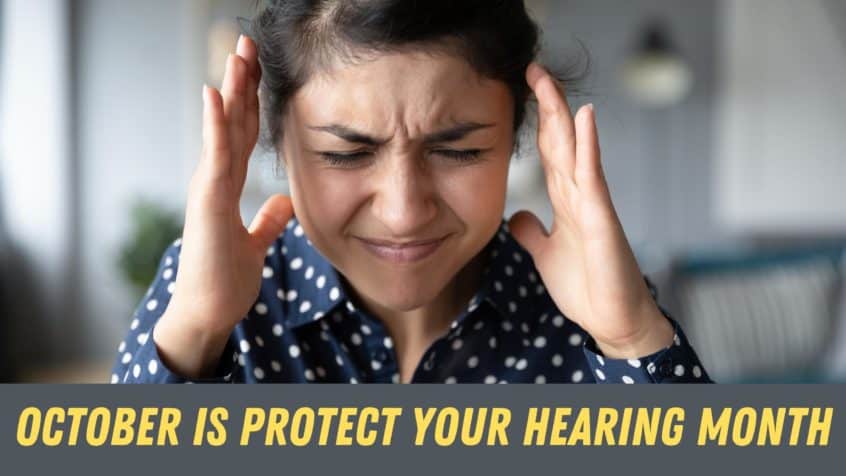October is Protect Your Hearing Month

October is Protect Your Hearing Month, and there’s no better time to schedule a hearing test. Whether you suspect you might have hearing loss or it’s simply been a while since your last hearing test, remember that hearing tests are an important part of maintaining your hearing health throughout your life.
The Better Hearing Institute, a not-for-profit organization, recommends that everyone get a hearing test once every decade until age 50, and once every three years after that. Regular hearing tests ensure that you can catch hearing loss before it becomes a problem, so you can take measures to protect your hearing in the situations that jeopardize it. Those in higher risk professions, or with a medical history indicating a higher risk for hearing loss, should be tested more frequently.
Noise-Induced Hearing Loss (NIHL)
Noise-induced hearing loss, or “NIHL,” is increasingly common among young people. While 10% of millennials have NIHL, Gen-Z’ers already have it at a rate of 17%. This is likely due to the increased popularity of louder events—like dances and music performances—as well as the increased use (and louder maximum volumes) of personal listening devices. Advances in technology have also allowed for the PA systems used at music performances and dances to be louder than ever.
Unfortunately, many people don’t even know they’re damaging their hearing. NIHL can set in at much lower volumes than most people realize. It’s not simply about loudness, but about the duration of exposure to loud sound.
As little as 85 dBA (decibels A-weighted) can cause NIHL after about 8 hours of exposure. 85 dBA is about the sound level of a gas-powered lawn mower, or some vacuum cleaners. For every additional 3 dBA of sound, the safe duration of exposure is cut in half. By the time we reach the sound level of an average high school dance—about 100 dBA—only a few minutes of exposure can cause permanent hearing loss.
Personal Listening Devices
The loudness of personal listening devices is harder to measure, since they inject the sound directly into our ear canals. In general, set the volume of your device just loud enough that you can hear the content clearly. Over-the-ear headphones tend to be safer than earbuds, in part because most headphones that fit over the ears also block some ambient sound, making it easier to hear the content at lower volumes.
Noise-Canceling Headphones
For those who spend a lot of time on transportation, a set of active noise-canceling headphones can be a great investment not only in hearing health but in a more pleasant listening experience. Active noise canceling works by using microphones to pick up the ambient sound. This is then played back by the headphone drivers in inverse polarity. Basically, the noise-canceling headphones playback the same sound that is present in the outside environment, but in an opposite way, such that the sound is effectively canceled out and never reaches the eardrums.
Earplugs
It’s good practice to carry a set of earplugs with you at all times. In particular, hunters and musicians require sophisticated earplugs that allow them to protect their hearing while simultaneously accessing the sounds they need to hear.
In case you find yourself in an unsafe listening environment, you can protect your ears while you’re there. If you’re unsure of whether an environment is sonically unsafe, you can download an SPL (Sound Pressure Level) meter app for your smartphone which can give you a rough idea of whether the sound is at dangerous levels.
Disposable Earplugs
Disposable earplugs are often made of a squishy foam material, and cost as little as $1.00/pair. You compress the foam, insert the earplugs, and it expands. Once expanded, it holds firmly in your ear canal and blocks incoming sound. They are good for one use, and then are meant to be discarded. While these are great in a pinch, they tend to attenuate high frequencies much more than lower frequencies, making for an unnatural listening situation.
Reusable Earplugs
Reusable earplugs cost a little bit more ($15–40), but are much more comfortable to wear and tend to have a more even degree of attenuation across the frequency spectrum. This makes them more suitable for music events. For those who expect to encounter loud sound on a regular basis, they are also a much better investment than disposables.
Custom Earplugs
Custom earplugs are the “Cadillac” of hearing protection. We take an impression of your ear canal, which is then sent to a specialized lab where a set of earplugs is made that fits your ears exactly. These are then loaded with a set of attenuators that are chosen based on your intended use. They are by far the best choice for musicians and regular concertgoers, as they provide the most even frequency response possible and are more comfortable for longer periods of wear. Learn more about our custom earplug solutions!
Schedule a Hearing Test
Whether you’re interested in custom hearing protection, hearing aids, or you’re just due for a hearing test, celebrate Protect Your Hearing Month by scheduling a hearing test with our team at Mt. Hood Hearing – and start keeping track of your hearing health!
